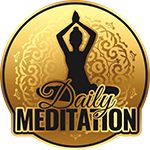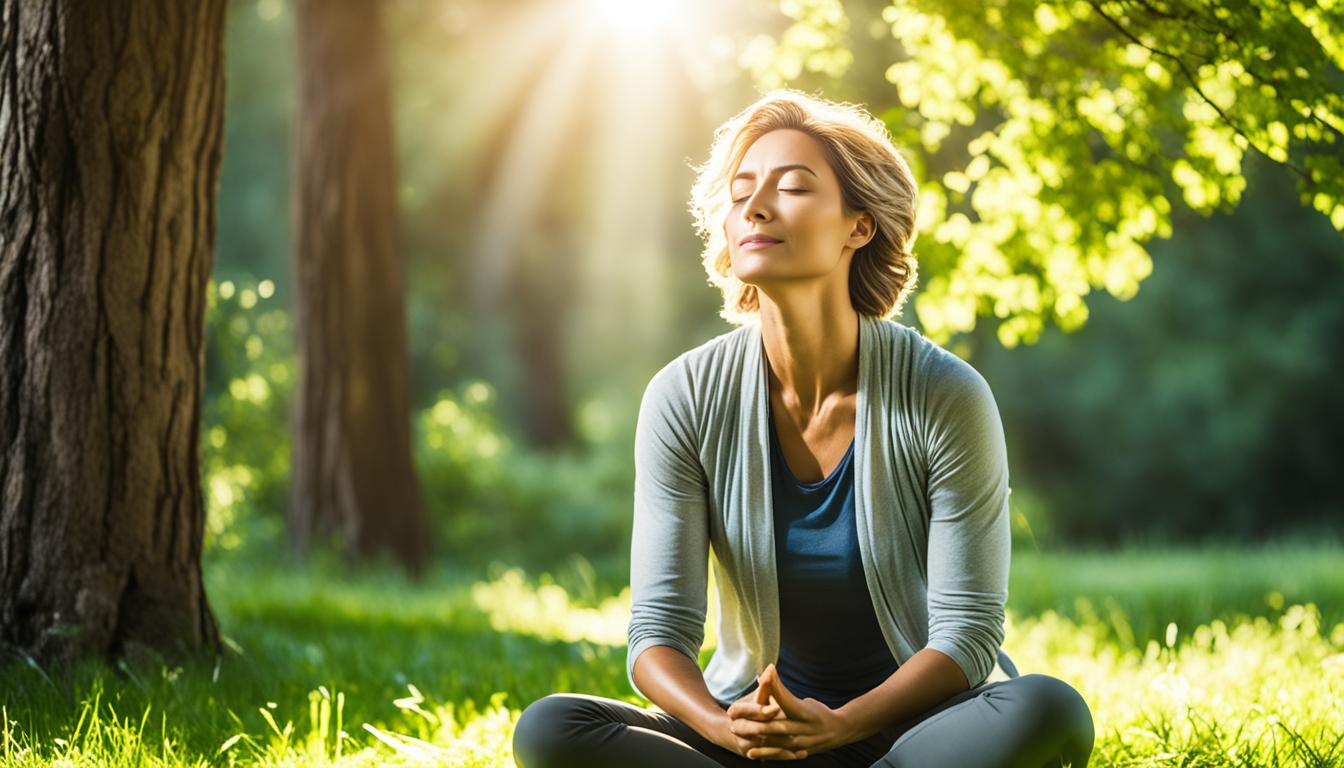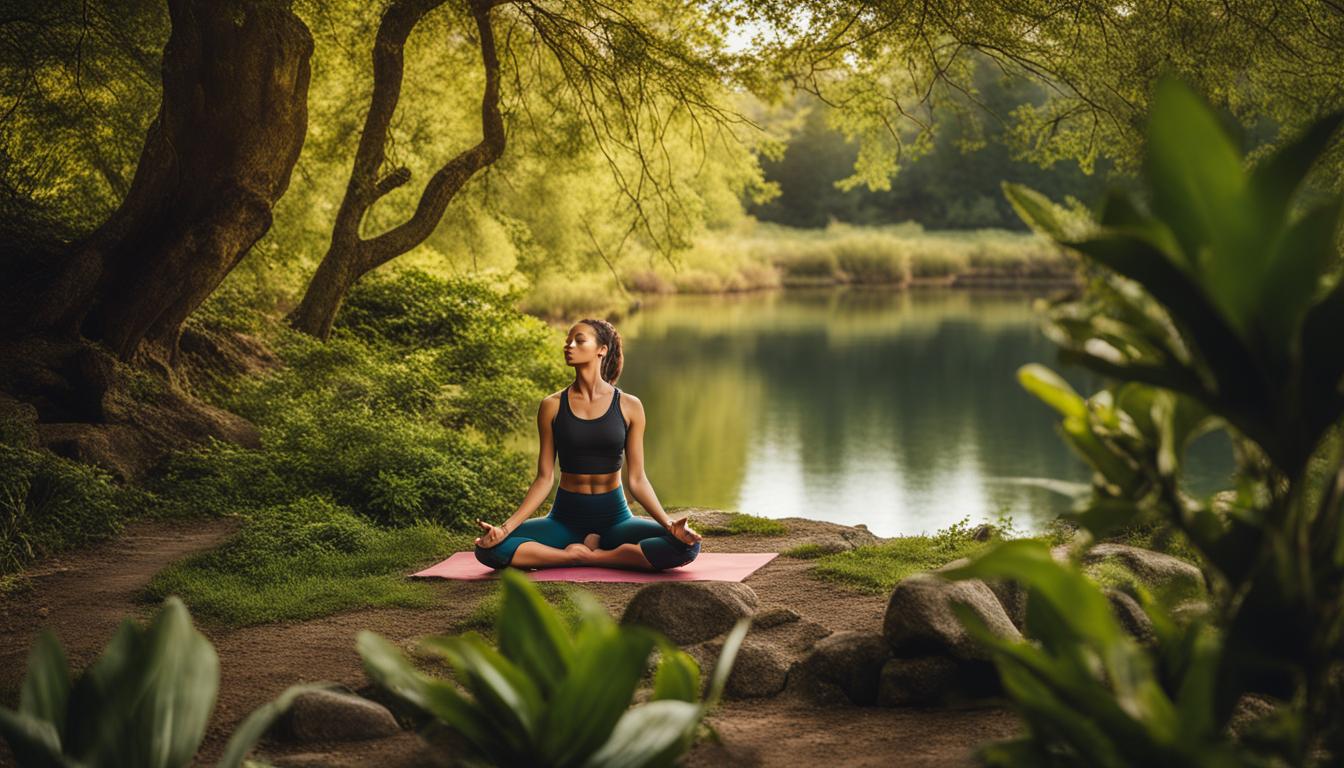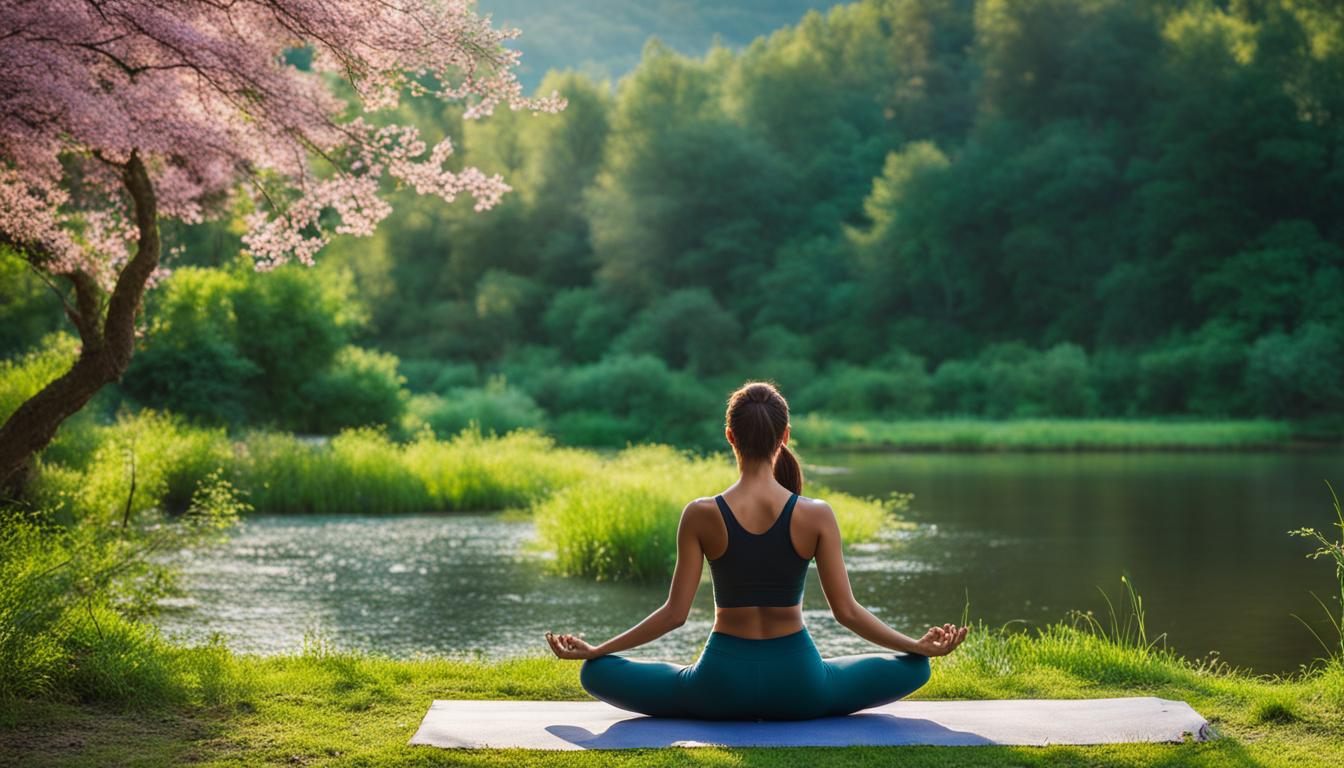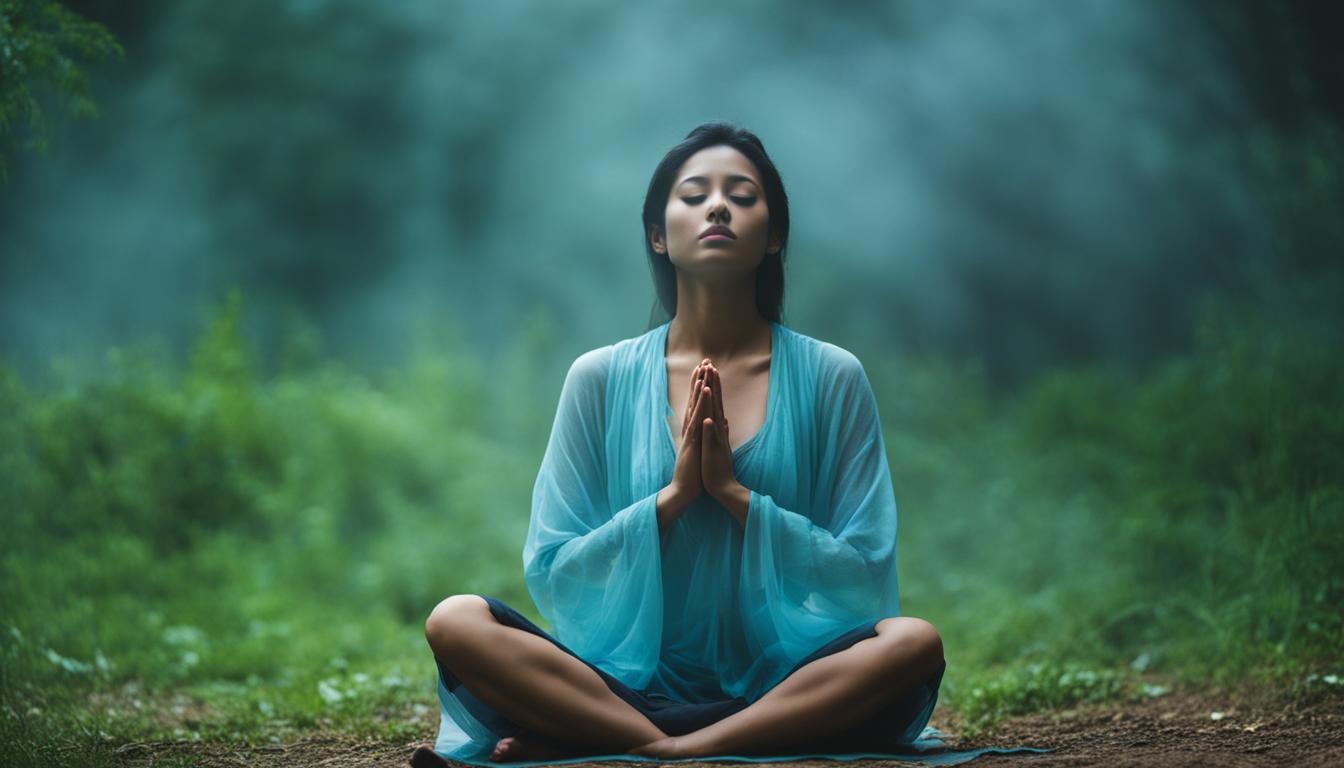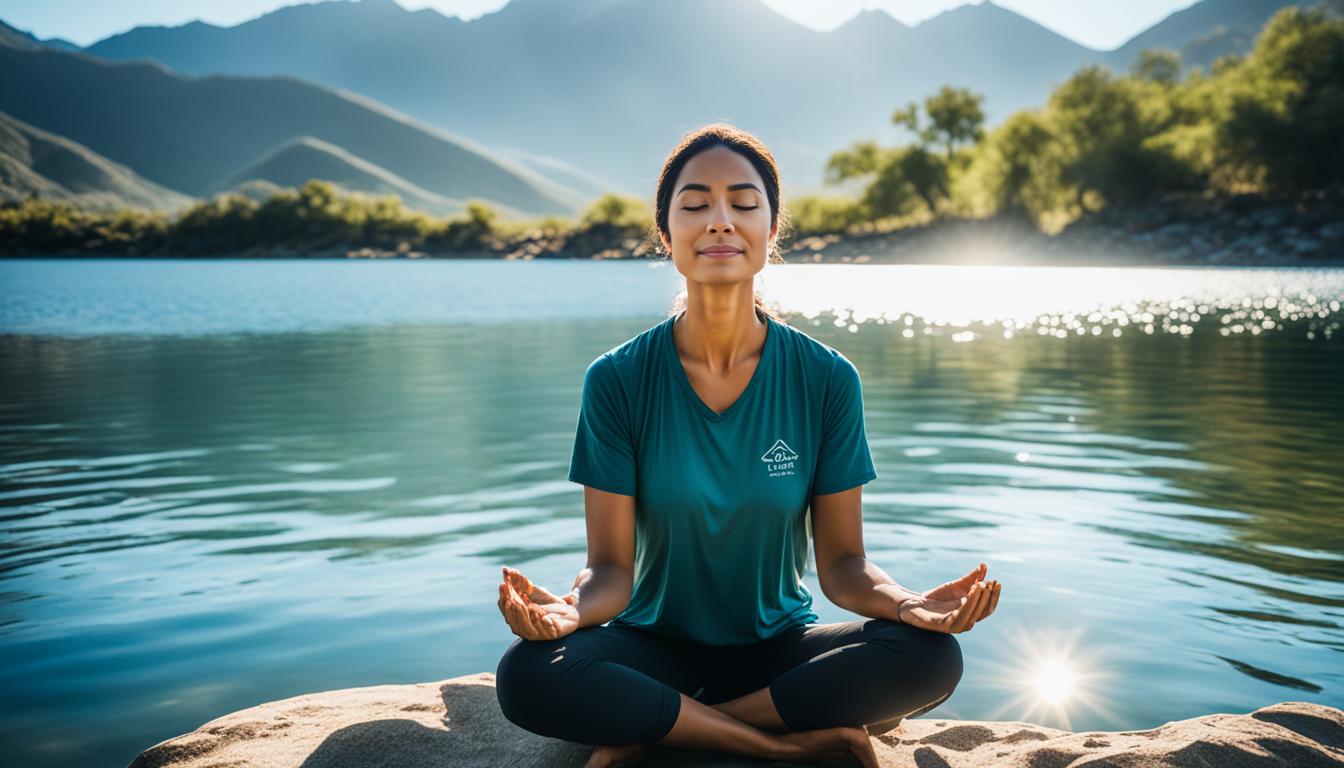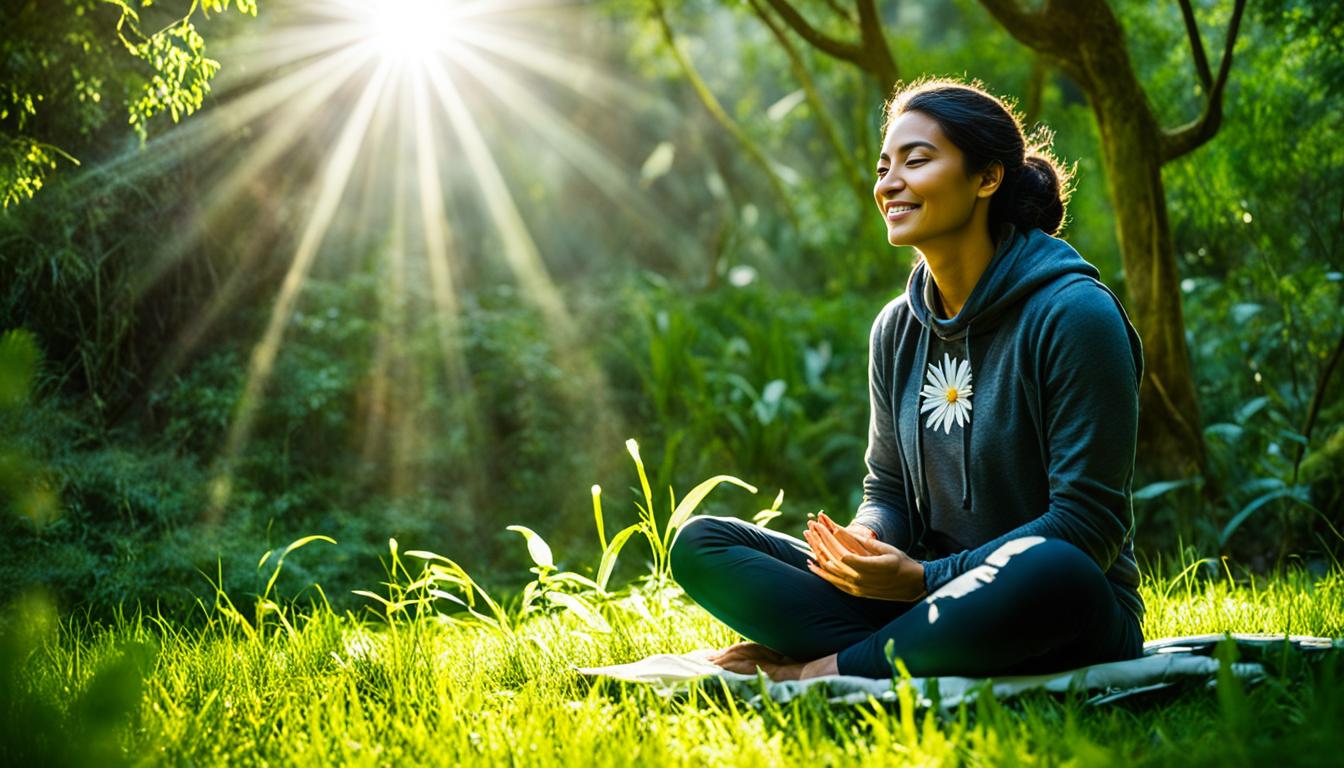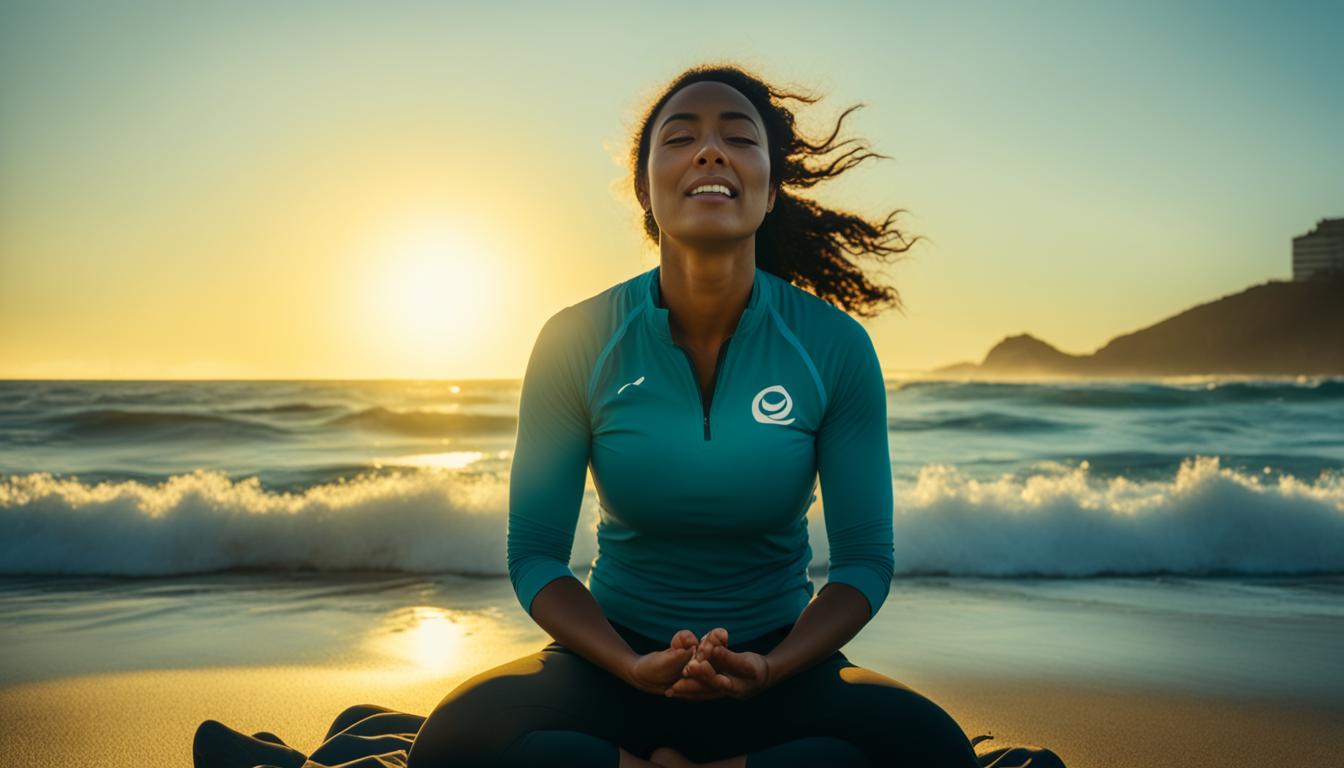Disclosure: This Post Contains Affiliate Links; We earn a commission on purchases.
Are you looking for effective ways to relax and relieve stress? Guided meditation can be a powerful tool to help you find peace and calm in your everyday life. By incorporating relaxation techniques into your routine, you can experience not only immediate stress relief but also long-term benefits for your overall well-being.
Relaxation techniques such as deep breathing, meditation, and yoga can activate the body’s natural relaxation response, reducing stress and promoting a sense of tranquility. The key is to find the technique that resonates with you, as there is no one-size-fits-all approach. Whether you’re a beginner or an experienced practitioner, guided meditation can be a valuable tool in your stress management toolbox.
Regular practice of guided meditation can help reduce stress and anxiety, improve sleep quality, and boost your mood. It allows you to connect with your body and mind, fostering a deeper sense of self-awareness and promoting inner peace.
Key Takeaways:
- Guided meditation is an effective technique for relaxation and stress relief.
- Relaxation techniques such as deep breathing, meditation, and yoga can activate the body’s natural relaxation response.
- Regular practice of guided meditation can help reduce stress and anxiety, improve sleep, and boost your mood.
- Find relaxation techniques that resonate with you and make them a part of your daily routine for optimal results.
- Guided meditation allows you to connect with your body and mind, promoting self-awareness and inner peace.
Deep Breathing Technique for Relaxation
Deep breathing is a simple yet powerful relaxation technique that can be practiced almost anywhere. By focusing on full, cleansing breaths, deep breathing can help slow your heart rate, lower your blood pressure, and reduce stress.
Deep breathing can be combined with other relaxation elements such as aromatherapy and music to enhance its effectiveness. Incorporating soothing scents or calming melodies into your deep breathing practice can create a more peaceful and immersive experience.
Follow these steps to engage in deep breathing:
- Sit comfortably with good posture, whether on a chair or cushion, ensuring your spine is straight and your shoulders relaxed.
- Breathe in through your nose, allowing the air to fill your lungs as your abdomen expands. Focus on a slow, steady inhalation.
- Exhale through your mouth, emptying your lungs completely and feeling any tension or stress leave your body as you release the breath.
- Continue this pattern of deep breathing, using your abdominal muscles to fully engage in each breath.
As you practice deep breathing, you may find it helpful to close your eyes and bring your attention solely to your breath. This can further enhance the relaxation and stress relief benefits of the technique.
Why Deep Breathing Works
Deep breathing activates the body’s relaxation response by stimulating the parasympathetic nervous system. This response helps counteract the effects of chronic stress and promotes a state of calm and relaxation.
By engaging in deep breathing regularly, you can train your body to naturally respond to stress with a relaxed and centered state of being. This can lead to improved overall well-being and a greater sense of ease in navigating the challenges of everyday life.
Engage in deep breathing whenever you feel overwhelmed or need a moment of calm. With practice, deep breathing will become a valuable tool for finding serenity and promoting relaxation in your daily life.
Progressive Muscle Relaxation Technique
Progressive muscle relaxation is a powerful technique that can help you release tension and stress from your body. By systematically tensing and relaxing different muscle groups, you can promote deep relaxation and experience a sense of calm. This technique is especially effective when combined with deep breathing, enhancing its stress-relieving benefits.
To practice progressive muscle relaxation, start by finding a quiet and comfortable space. Close your eyes and take a few deep breaths to center yourself. Begin with your feet and work your way up to your head, focusing on one muscle group at a time.
As you concentrate on each muscle group, tense the muscles for a few seconds, then release the tension. Pay attention to the sensations you feel when tensing and releasing the muscles, and allow yourself to fully relax between each contraction.
Here’s a step-by-step guide to progressive muscle relaxation:
- Feet: Scrunch your toes tightly, hold for a few seconds, then release.
- Calves: Point your toes towards your face, hold, then release.
- Thighs: Squeeze your thigh muscles, hold, then release.
- Buttocks: Clench your buttocks, hold, then release.
- Abdomen: Squeeze your abdominal muscles, hold, then release.
- Chest: Take a deep breath, filling your lungs, hold, then release.
- Shoulders: Shrug your shoulders up towards your ears, hold, then release.
- Arms: Clench your fists and flex your arm muscles, hold, then release.
- Neck: Tense your neck muscles by bringing your head back slightly, hold, then release.
- Jaw: Clench your jaw tightly, hold, then release.
- Face: Scrunch up your face muscles, hold, then release.
Continue practicing progressive muscle relaxation, gradually moving from one muscle group to another, until you’ve gone through your entire body. Remember to breathe deeply and focus on the relaxation of each muscle. With regular practice, you’ll develop a greater awareness of tension in your body, which can help you proactively manage stress in your daily life.
Image:
Body Scan Meditation for Relaxation
Body scan meditation is a powerful relaxation technique that promotes mindfulness and deep relaxation. By focusing your attention on different parts of your body, you can cultivate awareness of tension and stress, allowing for a deeper sense of relaxation. This technique is often used in mindfulness meditation practices and can be a valuable addition to your relaxation routine.
How to Practice Body Scan Meditation
To begin your body scan meditation, find a quiet and comfortable space where you can lie down and fully relax. Close your eyes and take a few deep breaths to center yourself.
Start by directing your attention to your toes. Notice any sensations, whether they are feelings of warmth, tingling, or relaxation. Allow yourself to connect with the present moment and simply observe the sensations without judgment.
Slowly move your attention up your body, focusing on each part individually. From your feet to your ankles, calves, knees, thighs, and so on, continue scanning each area and paying attention to any sensations that arise.
Remember, the goal of body scan meditation is not to change or evaluate any sensations but rather to bring awareness and acceptance to each part of your body. If you notice any tension or discomfort, simply observe it without judgment.
As you reach the top of your head, take a few moments to scan your entire body as a whole. Notice the overall sensation of relaxation and release any remaining tension or stress.
The Benefits of Body Scan Meditation
Body scan meditation offers numerous benefits for relaxation and stress relief. By practicing this technique regularly, you can experience:
- Increased mind-body awareness
- Greater sense of relaxation and calm
- Improved ability to recognize and release tension in the body
- Elevated mindfulness and presence in the present moment
- Reduced stress and anxiety
By incorporating body scan meditation into your relaxation routine, you can enhance your overall well-being and cultivate a deeper connection with your body.
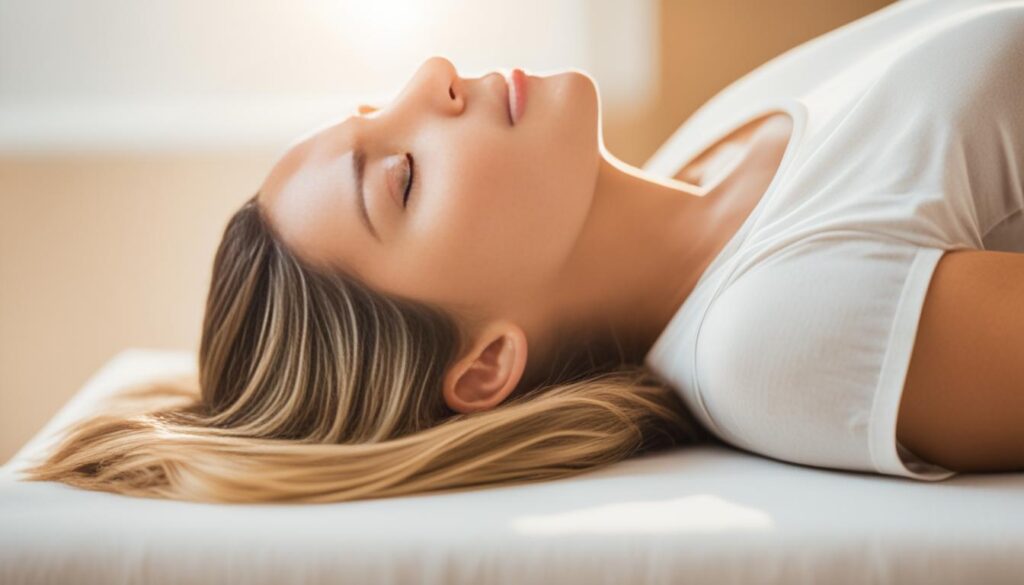
Try incorporating body scan meditation into your daily practice, and enjoy the profound relaxation and mindfulness it brings. Remember, consistency is key, so commit to making it a regular part of your routine for optimal results.
Guided Visualization for Relaxation
Guided visualization is a powerful relaxation technique that can transport you to a peaceful and serene environment, even if just in your mind. By engaging your imagination and focusing on sensory details, guided visualization can help to calm your thoughts, reduce stress, and promote a deep state of relaxation. Whether you choose to use a guided visualization recording or create your own imagery, this technique can be an effective tool in your relaxation toolkit.
The Power of Imagery
Imagery has long been recognized as a potent tool for relaxation and stress relief. When you engage your imagination and visualize yourself in a tranquil setting, such as a beautiful beach or a lush forest, your mind reacts as if you were actually there. By harnessing the power of imagery, guided visualization can help to lower your heart rate, relax your muscles, and alleviate tension throughout your body.
Imagination is more important than knowledge. For knowledge is limited, whereas imagination embraces the entire world, stimulating progress, giving birth to evolution.
– Albert Einstein
Step-by-Step Guided Visualization
- Find a quiet and comfortable space where you can relax without distractions.
- Close your eyes and take a few deep breaths to center yourself.
- Choose a peaceful scene or setting that resonates with you. It could be a beach, a mountain, a garden, or any place where you feel a sense of calm and tranquility.
- Begin to visualize yourself in that environment. Use your imagination to picture the sights, sounds, smells, and sensations associated with that place.
- Engage all your senses in the visualization. What do you see? What do you hear? What do you smell? How does the environment feel?
- Immerse yourself in the visualization and let go of any tension or stress. Allow the peaceful scene to wash over you and bring a sense of deep relaxation.
- Stay in the guided visualization for as long as you feel comfortable, enjoying the serene environment and experiencing the benefits of deep relaxation.
- When you are ready to conclude the guided visualization, slowly bring your awareness back to the present moment. Take a few deep breaths and allow yourself to fully reorient.
Benefits of Guided Visualization
Guided visualization can offer a range of benefits for relaxation and stress relief. By engaging your imagination and creating a mental oasis, you can experience:
| Benefits of Guided Visualization |
|---|
| Reduction in stress and anxiety |
| Improved sleep quality |
| Enhanced mood and well-being |
| Increased self-awareness and mindfulness |
| Improved focus and concentration |
By incorporating guided visualization into your relaxation routine, you can tap into the power of your own mind to promote relaxation, reduce stress, and enhance your overall well-being.
Self-Massage Techniques for Stress Relief
Massage is a well-known method for reducing stress and tension. While professional massages are great, self-massage can also provide similar benefits. Take a few minutes to massage yourself, focusing on areas where you feel tension, such as the neck and shoulders. Use gentle strokes, tapping, and kneading techniques to release muscle tension and promote relaxation. Combine self-massage with mindfulness or deep breathing for a more comprehensive stress relief experience.
Self-massage is a convenient and cost-effective way to alleviate stress and unwind. By performing simple techniques on yourself, you can target specific areas of tension in your body and induce a state of relaxation. Remember to create a calm and inviting environment before starting your self-massage session. Play soft music, light scented candles, or use essential oils to enhance the soothing experience.
Neck and Shoulder Massage
The neck and shoulder area is a common area where people hold stress and tension. Self-massage techniques can help release knots and tightness in these muscles, providing instant relief. Here’s a simple self-massage routine for your neck and shoulders:
- Sit or stand in a comfortable position with your shoulders relaxed.
- Using your fingertips, apply gentle pressure to the base of your skull and move your fingers down towards the tops of your shoulders. Repeat this motion several times.
- Place your right hand on your left shoulder and use circular motions to massage the muscle. Repeat on the other side.
- For deeper relaxation, use your left hand to apply pressure on specific points along the muscles of your right shoulder and vice versa.
- Continue massaging and kneading the muscles until you feel tension releasing.
Remember to breathe deeply and focus on the sensation of your muscles relaxing as you perform the self-massage. This will enhance the overall relaxation experience.
Benefits of Self-Massage
Self-massage offers numerous benefits for both the body and mind. Some of the key benefits include:
- Relief from muscle tension and pain
- Improved circulation and lymphatic flow
- Reduced stress and anxiety levels
- Enhanced relaxation and improved sleep
- Increased self-awareness and mindfulness
By incorporating self-massage into your regular routine, you can enjoy these benefits and take proactive steps towards managing stress and promoting overall well-being.
Discover the power of self-massage and explore different techniques to find what works best for you. Whether it’s a quick neck and shoulder massage or a full-body self-massage routine, the key is to make self-care a priority. Combine self-massage with other relaxation techniques, such as deep breathing or mindfulness meditation, to create a personalized stress relief practice.
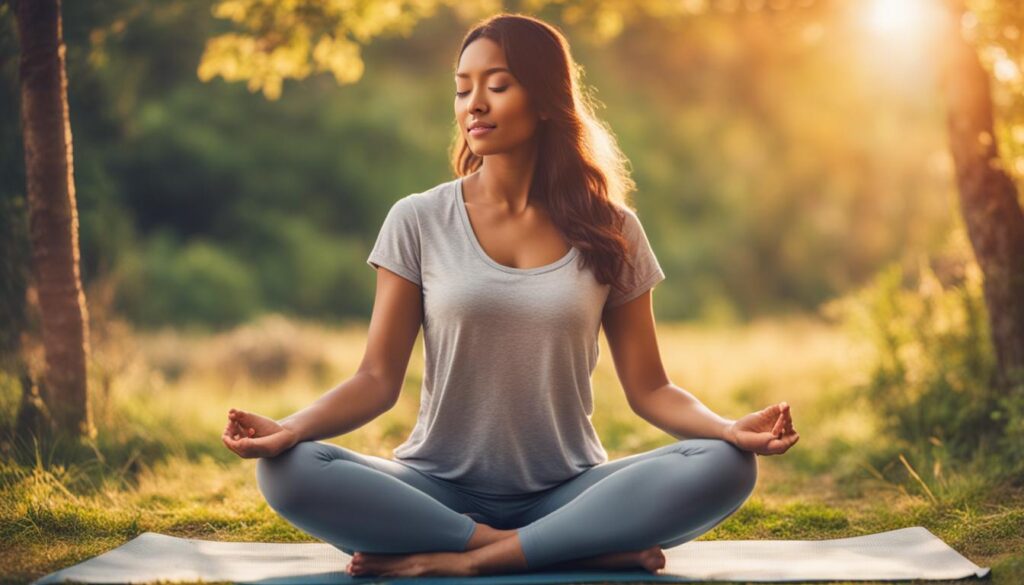
Mindfulness Meditation for Stress Relief
Mindfulness meditation is an effective relaxation technique that can provide immense stress relief. By bringing your attention to the present moment and accepting it without judgment, mindfulness meditation helps calm the mind and reduce anxiety. This practice involves focusing on your breath, sensations, and thoughts without becoming attached to them. It has been scientifically proven to have numerous benefits for both mental and physical well-being.
Regular practice of mindfulness meditation can:
- Reduce stress and anxiety levels
- Cultivate a sense of calm and peace
- Improve concentration and focus
- Promote emotional well-being
- Enhance self-awareness and acceptance
One of the key components of mindfulness meditation is focusing on the breath. Paying attention to the sensation of each inhalation and exhalation can help anchor your awareness in the present moment and quiet the mind.
Mindfulness meditation is not about emptying the mind or achieving a specific outcome. It is about observing your thoughts and emotions without judgment and learning to be present in the moment.
To practice mindfulness meditation, follow these steps:
- Find a quiet and comfortable space where you won’t be interrupted.
- Sit in a relaxed position, with your back straight and shoulders relaxed.
- Close your eyes and take a few deep breaths to center yourself.
- Focus your attention on your breath, feeling the sensation of each inhale and exhale.
- If your mind wanders, gently bring your attention back to your breath without judgment.
- Continue to observe your breath for a few minutes or as long as you like.
- When you’re ready to end the practice, gradually bring your awareness back to the present moment.
Mindfulness meditation can be done for just a few minutes a day or longer, depending on your preference and schedule. Consistency is key, so aim to practice mindfulness meditation regularly to experience its full benefits.
Mindfulness Meditation Tips:
- Start with short meditation sessions and gradually increase the duration.
- Experiment with different guided meditation apps or recordings to find what works best for you.
- Combining mindfulness meditation with other relaxation techniques, such as deep breathing or progressive muscle relaxation, can enhance the overall experience.
- Consider joining a meditation group or taking a mindfulness course to deepen your practice.
| Benefits of Mindfulness Meditation | Scientific Studies |
|---|---|
| Stress reduction | A study published in the Journal of Consulting and Clinical Psychology found that mindfulness-based stress reduction (MBSR) significantly decreased stress levels in participants compared to a control group. |
| Anxiety management | Research conducted at Johns Hopkins University found that mindfulness meditation can be as effective as medication for managing anxiety disorders. |
| Improved well-being | A meta-analysis of 209 studies published in the Journal of Happiness Studies concluded that mindfulness meditation has a positive impact on overall well-being and life satisfaction. |
Tips for Incorporating Meditation into Daily Life
To make the most of the benefits of meditation, it’s important to incorporate it into your daily life. Here are some tips to help you establish a regular meditation practice:
- Find a quiet space: Choose a peaceful location in your home or outdoors where you can meditate without distractions. It could be a cozy corner, a park, or even your backyard.
- Set aside dedicated time: Start with just a few minutes each day and gradually increase the duration as you become more comfortable with meditation. Consistency is key, so find a time that works best for you, whether it’s in the morning, during lunch break, or before bed.
- Experiment with different techniques: There are various meditation techniques to explore, such as mindfulness, guided visualization, or chanting. Try different techniques to find the one that resonates with you and brings you the most relaxation and stress relief.
- Use apps and resources: There are many meditation apps available that offer guided meditation sessions for beginners and experienced meditators alike. These apps can provide structure and guidance as you develop your practice.
- Integrate meditation into your routine: Consider incorporating meditation into your daily routine by combining it with other activities. For example, you can practice mindfulness while taking a walk or integrate guided meditation into your journaling or bedtime routine.
- Stay committed: Like any habit, meditation requires dedication and persistence. Some days may be more challenging than others, but remind yourself of the benefits you experience and keep coming back to your practice.
Remember, meditation is a personal journey, and what works for one person may not work for another. Be patient with yourself as you explore different techniques and find the approach that brings you the most peace and stress relief.
Meditation Benefits at a Glance:
| Benefits of Meditation | Description |
|---|---|
| Stress Relief | Meditation helps reduce stress and promotes relaxation, allowing you to better cope with daily challenges. |
| Improved Focus | Regular meditation practice enhances focus and concentration, improving productivity and mental clarity. |
| Emotional Well-being | Meditation cultivates emotional balance, reduces anxiety and depression, and enhances overall well-being. |
| Better Sleep | By calming the mind and relaxing the body, meditation can improve the quality of sleep, helping you wake up refreshed. |
| Enhanced Self-Awareness | Meditation fosters self-discovery and self-reflection, helping you gain a deeper understanding of yourself and your emotions. |
| Increased Resilience | Regular meditation practice builds resilience, enabling you to navigate life’s challenges with greater ease and grace. |
Conclusion
Guided meditation for relaxation and stress relief offers a wide range of benefits for managing everyday stress and improving overall well-being. By incorporating various relaxation techniques into your daily routine, such as deep breathing, progressive muscle relaxation, body scan meditation, guided visualization, self-massage, and mindfulness meditation, you can experience deep relaxation, better sleep, and reduced stress and anxiety.
It’s essential to explore different techniques and find what resonates with you. There is no one-size-fits-all approach to relaxation, so experiment and discover which methods bring you the most peace and tranquility. Once you find the techniques that work best for you, make meditation a regular part of your life.
By incorporating guided meditation into your daily routine, you can fully reap the benefits of relaxation and stress relief. Whether you start your day with a few minutes of deep breathing or wind down in the evening with a body scan meditation, integrating these practices into your life can significantly improve your overall well-being and help you navigate life’s challenges with greater ease.
Source Links
- https://www.helpguide.org/articles/stress/relaxation-techniques-for-stress-relief.htm
- https://mindfulnessexercises.com/guided-meditation-anxiety-stress-beginning-meditation-guided-imagery-visualization-video/
- https://www.audible.com/pd/Guided-Meditation-for-Stress-Relief-Audiobook/B084H3R7Q9
Ryan Conlon is a passionate advocate for mindfulness and meditation, dedicated to helping others discover the transformative power of these practices in their lives. As the founder of Daily Meditation, Ryan’s mission is to provide a sanctuary for individuals seeking peace, clarity, and well-being amidst the chaos of modern life. With a background in psychology and years of personal experience with meditation, Ryan brings a wealth of knowledge and insight to his work. Through Daily Meditation, he shares practical guidance, inspirational content, and expert resources to support others on their journey toward greater mindfulness, resilience, and inner peace.
Subscribe to Our Newsletter
